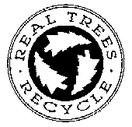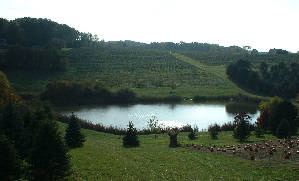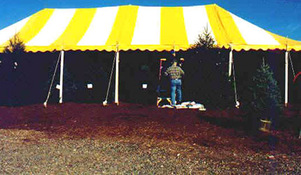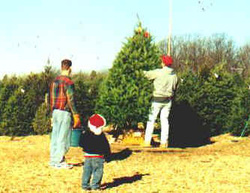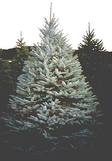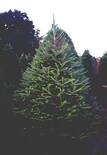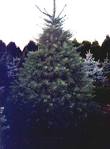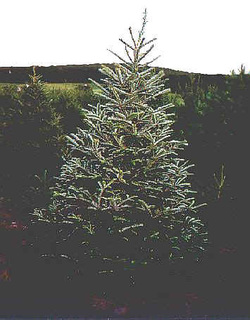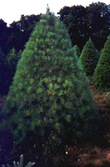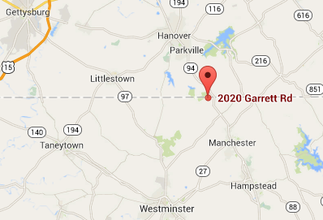Your Guide To Selecting the Perfect Tree!
2023 Pricing: Every effort is made to keep website info up to date. In the event of a discrepancy, posted prices at the farm prevail.
- Prices for cut your own trees up to 6-9.5' are $80-$157 depending on the variety and height
-Trees less than 6' are at the 6' price ($80-88) so check the tent for small trees to get a better value.
- Trees 10'-11' are $19.5 per ft. Trees 11.5'-13,5' are $20.50 per ft. Trees 14' - 16' $25.2/ft. Over 16' are TBD at time of cutting, starting at $500. If you want a huge tree, we suggest shopping in the precut tent as we may not be able to assist you in the field.
- Fresh cut trees in our tent (from our own farms) are priced individually for size & quality, starting at $25 and ranging up to over $800 for cathedral height trees.
Trees in the field are intended as 'you-cut/you move'. If you are not able to cut/move your tree consider selecting a tree we have already prepared in the pre-cut area. We are happy to assist if needed but please note that during peak times we may not have staff available. If you require assistance, please tag your tree and arrange to pick up during the week.
All prices are plus MD sales tax.
- Prices for cut your own trees up to 6-9.5' are $80-$157 depending on the variety and height
-Trees less than 6' are at the 6' price ($80-88) so check the tent for small trees to get a better value.
- Trees 10'-11' are $19.5 per ft. Trees 11.5'-13,5' are $20.50 per ft. Trees 14' - 16' $25.2/ft. Over 16' are TBD at time of cutting, starting at $500. If you want a huge tree, we suggest shopping in the precut tent as we may not be able to assist you in the field.
- Fresh cut trees in our tent (from our own farms) are priced individually for size & quality, starting at $25 and ranging up to over $800 for cathedral height trees.
Trees in the field are intended as 'you-cut/you move'. If you are not able to cut/move your tree consider selecting a tree we have already prepared in the pre-cut area. We are happy to assist if needed but please note that during peak times we may not have staff available. If you require assistance, please tag your tree and arrange to pick up during the week.
All prices are plus MD sales tax.
After choosing a tree, bring it to a baling station where someone from our staff will place your tree on our shaker to remove any loose needles, leaves, snow or other debris. Then we can bale it for your easy handling. We will even help load your vehicle. Note: trees over 14' may not be able to be baled or drilled. Please stay with your tree while it is being processed, and get your tag from the baler crew. After paying in the gift shop, bring your numbered ticket to the tree rack to pick up.
Cathedral Height Trees
Looking for a tree 10' or over? This is the place! We have lots to choose from in our fresh-cut area, or you may cut your own. We have trees as tall as 18 feet!! We are happy to assist with these monster trees, but we appreciate your understanding that we may not be able to do so during peak hours. If you have selected a tree a little too big to handle on your own, please tag it and arrange to pick up during the week when we have staff on hand to assist. Remember.....the per-foot price changes on the big trees - we encourage you to consider those already cut and priced in the pre-cut tent so that you know exactly what the price will be. UPDATE: We will not be able to assist with monster field trees on 11/24-11/26 or 12/2-12/3. Please tag your tree, note it's location, and arrange pickup on a weekday. We strongly suggest selecting a precut tree from the tent - these trees are hand picked for quality and the price is about the same.
Tree Drilling
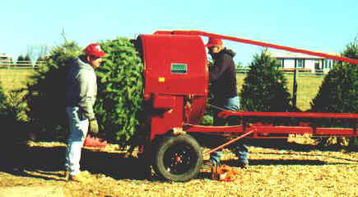
What is tree drilling? It is one of the easiest ways to set up your tree. We have purchased equipment that drills a vertical hole in the trunk of your tree. A special stand is available with a peg that exactly matches the drilled hole in the tree. When you get home, simply tap the peg into the hole, stand up your tree and unbale. Your tree stands straight the first time. No screws or braces to adjust. Setting up your tree has never been easier (or less frustrating). Also, there is no charge for drilling your tree.
After drilling and trimming your tree, we will bale your tree for you making it cleaner and easier to get it home. Our baling machine is setup to accommodate most any size tree, but trees in excess of 14' may not be able to be baled or drilled. As always, Shaking, Trimming, Drilling, and Baling are free to you at Showvaker's.
After drilling and trimming your tree, we will bale your tree for you making it cleaner and easier to get it home. Our baling machine is setup to accommodate most any size tree, but trees in excess of 14' may not be able to be baled or drilled. As always, Shaking, Trimming, Drilling, and Baling are free to you at Showvaker's.
Tree Terms & Frequently Asked Questions
Leader: this term refers to the portion of the tree that projects vertically from the center of the tree. Each year, as the tree grows, the previous year's leader widens and becomes a portion of the stump.
Whirl: As the leader grows, branches also extend in a more horizontal manner from the previous year's leader, creating a 'whirl' of branches around the leader.
How long does it take to grow a Christmas tree? Of course, there are faster and slower varieties but on average, evergreens grow about a foot per year. As the tree is growing up (from the leader), it is also growing out (from the whirls of branches). That's a lot of work for your little tree!
Do evergreens naturally grow in the shape of Christmas trees? The answer is yes, but with help. Since the tree is growing both up and out at the same time, it can become misshapen if one part grows faster than the other. If the top grows faster, the leader will be excessively long, sometimes two-three feet (and remember, the tree is only supposed to be growing at about a foot per year). If the branch-whirls grow faster, the leader will be too short proportionately resulting in a very tight distance between whirls - sometimes too tight to hang ornaments. We help the process along by checking every tree each year, trimming long leaders if needed or pruning the sides to encourage top growth.
How are trees measured? After you have selected your tree we will measure it. We do not include excessive trunk or an excessive top (say if the tree hadn't been sheared). There are two terms used in the industry. Stumping, which is cutting your tree shorter in the field and leaving a portion still in the ground on the stump. The other is topping. This term refers to removing the top of your tree, either the central leader or the entire top whirl. We don't encourage stumping, but we don't charge for missing tree-bottoms. Topping is another matter - we need the top of your tree to accurately measure. Without it, we must estimate. If you want the top removed from your tree, please do so after your tree is measured.
Whirl: As the leader grows, branches also extend in a more horizontal manner from the previous year's leader, creating a 'whirl' of branches around the leader.
How long does it take to grow a Christmas tree? Of course, there are faster and slower varieties but on average, evergreens grow about a foot per year. As the tree is growing up (from the leader), it is also growing out (from the whirls of branches). That's a lot of work for your little tree!
Do evergreens naturally grow in the shape of Christmas trees? The answer is yes, but with help. Since the tree is growing both up and out at the same time, it can become misshapen if one part grows faster than the other. If the top grows faster, the leader will be excessively long, sometimes two-three feet (and remember, the tree is only supposed to be growing at about a foot per year). If the branch-whirls grow faster, the leader will be too short proportionately resulting in a very tight distance between whirls - sometimes too tight to hang ornaments. We help the process along by checking every tree each year, trimming long leaders if needed or pruning the sides to encourage top growth.
How are trees measured? After you have selected your tree we will measure it. We do not include excessive trunk or an excessive top (say if the tree hadn't been sheared). There are two terms used in the industry. Stumping, which is cutting your tree shorter in the field and leaving a portion still in the ground on the stump. The other is topping. This term refers to removing the top of your tree, either the central leader or the entire top whirl. We don't encourage stumping, but we don't charge for missing tree-bottoms. Topping is another matter - we need the top of your tree to accurately measure. Without it, we must estimate. If you want the top removed from your tree, please do so after your tree is measured.
Tree Care
Did you know that a freshly cut tree can drink as much as two gallons of water per day? Talk about being thirsty! To best care for your tree, place it in water as soon as you get home. The first few days you may need to water 2-3 times per day, so be sure that your stand is large enough to keep the base of your tree covered between watering. Here are some other tips to care for your tree.
- Make a fresh, flat cut to remove about a 1/2-inch from the base of the trunk before putting the tree. We do this before you leave the farm, but if it's been more than six hours we suggest it be done again. However, keep in mind that if you have the drilled hole for the pin-stand you will be shortening the depth of the hole so remove the smallest amount possible. Your best bet is to take your tree straight home and place in water. The cut should be flat (not angled or or V-shaped) as this provides the most area for water uptake.
- Water temperature is not important, although some folks like to use warm (not hot) water for the first watering to loosen any dried sap on the trunk.
- Drilling a hole in the base of the trunk does NOT improve water uptake. The hole we drill is to accommodate the pin-type tree stand that we recommend.
- Don't remove bark from the stump of the tree or narrow the trunk to fit into a stand - the bark is necessary for the best absorption of water.
- If you aren't ready to bring your tree indoors when you get home, store it in a cool, shady spot - preferably in water - until you are ready. Keep the cut end free of debris to facilitate water uptake and don't allow the water to freeze.
- Keep trees away from major sources of heat (fireplaces, heaters, heat vents, direct sunlight).
- Lower the room temperature or cover heat vents in the room where the tree is located.
- Use low-heat or miniature lights that have been inspected before using.
- Always turn off the tree lights when leaving the house or when going to bed.
- Monitor the tree for freshness. A tree that has become dry should be removed from your home.
- After Christmas, your tree can be recycled - check with your local community for info.
- Never burn any part of a Christmas tree in a wood stove or fireplace.
Tree Aroma
We have been asked the question, "Do different varieties of trees smell differently?" The answer is 'yes'! But which smells the best is entirely subjective. Some have a hearty, woodsy aroma, while others have a fresh, sweet scent. In fact, Concolor Fir don't smell like pine at all - they have a fragrance of citrus! To test which you prefer, simply break off a needle or two (from an inconspicuous spot, please!) and crush gently between your fingers.

